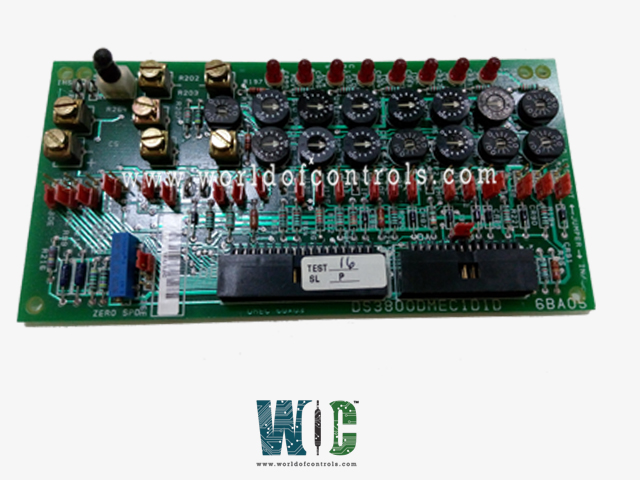
World Of Controls understands the criticality of your requirement and works towards reducing the lead time as much as possible.
DS3800DMEC - Drive Motor Excitation Controller Board is available in stock which ships the same day.
DS3800DMEC - Drive Motor Excitation Controller Board comes in UNUSED as well as REBUILT condition.
To avail our best deals for DS3800DMEC - Drive Motor Excitation Controller Board, contact us and we will get back to you within 24 hours.
SPECIFICATIONS:
Part Number: DS3800DMEC
Manufacturer: General Electric
Series: Mark IV
Product Type: Drive Motor Excitation Controller Board
Number of channels: 12
Operating temperature: -30 to 55 degrees Celsius
Size: 8.25 cm high x 4.18 cm
Repair: 3-7 Day
Availability: In Stock
Weight: 2 lbs
Country of Origin: United States
FUNCTIONAL DESCRIPTION:
DS3800DMEC is a Drive Motor Excitation Controller Board manufactured and designed by General Electric as part of the Mark IV Series used in GE Speedtronic Gas Turbine Control Systems. This board is responsible for managing the electrical current flowing through the motor windings to ensure the proper generation of magnetic fields. Key functions of a Motor Excitation Controller Board may include:
Field Weakening Control: In some applications, it might be necessary to weaken the magnetic field to control the motor speed more precisely. The excitation controller can adjust the field weakening to achieve the desired motor performance.
Speed Control: The board often includes circuits to regulate the speed of the motor by adjusting the excitation level. This is crucial for applications where variable speed control is required.
Torque Control: The controller can manage the torque produced by the motor, ensuring that it meets the requirements of the application.
Fault Protection: Motor excitation controllers usually incorporate safety features to protect the motor from overcurrent, overvoltage, or other fault conditions. This helps in preventing damage to the motor and the controller itself.
Communication Interface: Some controllers may include communication interfaces (such as RS-485 or Ethernet) to enable external control or monitoring of the motor system.
Feedback Systems: The controller often integrates feedback mechanisms like encoders or sensors to provide information about the motor's current state. This feedback is crucial for closed-loop control systems.
WOC maintains the largest inventory of Replacement parts for GE Speedtronic control systems. Additionally, we offer warranty-backed unused and rebuilt boards as well as board repairs for your damaged ones. For your OEM needs, our team of professionals is available around the clock. We at WOC are happy to help you with any needs you may have in terms of automation. Please contact our team by phone or email for pricing and availability on any components and repairs.
What is a Motor Excitation Controller Board?
A Motor Excitation Controller Board is an electronic device that regulates the excitation of a motor. It controls the flow of electrical current to the motor windings, managing factors such as speed, torque, and field weakening.
Why is Motor Excitation Control Important?
Motor excitation control is essential for optimizing the performance of electric motors. It enables precise adjustments to speed, torque, and other parameters, ensuring efficient and reliable operation in various applications.
What Types of Motors Use Excitation Controllers?
Various types of motors, including DC motors, AC induction motors, and synchronous motors, may use excitation controllers. The specific type depends on the motor technology and the requirements of the application.
What Functions Does a Motor Excitation Controller Perform?
A Motor Excitation Controller performs functions such as speed control, torque control, field weakening, and fault protection. It may also include communication interfaces for external control and feedback systems for monitoring.